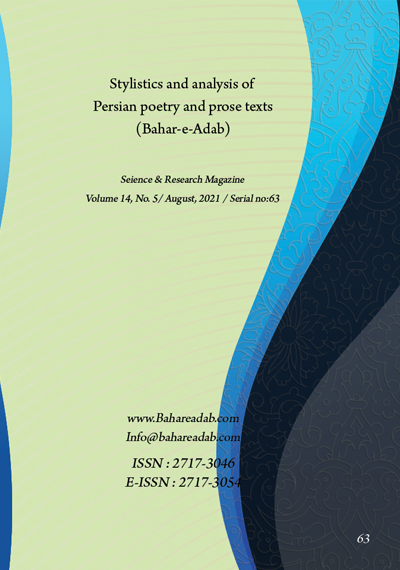- Count View : 451
- آدرس کوتاه شده مقاله: https://bahareadab.com/article_id/1121
- کد doi مقاله: Doi: 10.22034/bahareadab.2021 .14 .5439
Journal of the stylistic of Persian poem and prose
volume Number 14،
number In Volume 5،
،
issue Number 63
Investigation and Analysis of Linear manuscripts of osol –al ـ fosol fi hosol ـ al ـ vosol
Saeed Abedini , Azizollah Tavakoli Kafiabad (Author in Charge), Mahmoud Sadeghzadeh
Abstract
BACKGROUND AND OBJECTIVES: The manuscript "Principles of Seasons in Achieving Achievements" by Rezaghili Khan Hedayat (1215-1288 AH) is one of the authors of the Qajar era in the thirteenth century AH This work has not been edited or published yet. The book is a mystical encyclopedia in which the author deals with the course of mysticism from the past to the present. So far, two copies of this book have been introduced in the libraries of the Majlis and Bu Ali University of Hamadan. The guidance of this book is written in eighteen chapters and the attention to the eighteen principles of the book shows the essence of Sufism of the Qajar era. Given the historical and literary importance of this work, the author seeks to introduce the version of the principles of the chapters and study and the elements and components of style, expressing its linguistic features, literary, religious, mystical and historical value. Introducing this work, in addition to showing its literary status, will also be effective in explaining the scope of mysticism and Sufism.
METHODOLOGY: This research was conducted by descriptive-analytical method with the help of library resources.
FINDINGS: The author first introduces the mystical dynasties and then introduces the Nematullah dynasty and the life of Shah Nematullah Vali. From the point of view of linguistic structure, Hedayat has tried to use the language of the past and their linguistic practice in order to make his work acceptable to the general public; Hence, it has made extensive use of ancient uses of language.
CONCLUSION: Hedayat prose is mature and stable and far from difficulty and complexity, for this reason and due to the proximity of this work to our time, it does not have special and privileged stylistic features, and since this prose work, along with verses from other poets" poems It has cases of stylistic coordinates.
Keyword
Manuscript
, Reza Qoli Khan
, Principles of Chapters in Achieving Achievements
, Stylistics
, Qajar Period.
- The Holy Quran. (2008). Translated by the late Mehdi Elahi Ghomshei, seventh edition, Tehran: Payam Azadi. Arinepour, Yahya. (2003). From Saba to Nima, Tehran: Zavar, p. 50.
- Az-Dawla, Ahmad Khan. (1997). History of Azdi, Edited by Abdolhossein Nedayi, Tehran: Elm, p. 219.
- Bahar, Mohammad Taghi. (1994). Stylistics, Tehran: Amirkabir, p. 348.
- Haqshenas, Ali Mohammad. (1997). Phonetics. Tehran: Naqsh Jahan, pp. 11-12.
- Hedayat, Reza Ghali Khan, Principles of Chapters in Achieving Achievements, Majlis Library, No. 2103 (written).
- Hedayat, Reza Ghali Khan. (1957). Rozato Al-Safa Naseri, Edited by Jamshid Kiafar, Tehran: Myths.
- Hedayat, Reza Ghali Khan. (1994). Fehrest –ol Tavarikh, Edited by Abdolhossein Navai and Mirhashem Mohaddes, Tehran: Institute of Humanities.
- Hedayat, Reza Ghali Khan. (2001). Majmaol Fosaha, Correction of the manifestations of the refinery, Tehran: Amirkabir, p. 8770.
- Hedayat, Reza Qali Khan. (N. D). Principles of Chapters in Achieving Achievements, Bu Ali Sina University of Hamadan, No. 107 b. (Linear).
- Hosseini Eshkori, Ahmad. (2005). Index of Manuscripts in the Library of Bu Ali University, Qom: Publication of the Islamic Reserves Association.
- Hosseini Eshkori, Ahmad. (2005). List of Manuscripts in the Library of Bu Ali University, Qom: Publication of the Islamic Reserves Association.
- Mashkooh al-Dini, Mehdi. (2005). Persian grammar, Tehran: Samt, p. 130.
- Mokhber-ol saltane. (1982). Memoirs and Dangers, Third Edition, Tehran: Zavvar Bookstore, p. 28.
- Nafisi, Saeed. (1965). Index of the Library of the National Assembly, Tehran: Parliament Press, Vol 6.
- Shamisa, Sirus. (2008). Bayan, Third Edition, Tehran: Mitra, p. 38.

